12 April 2020
1916 Chronology of events
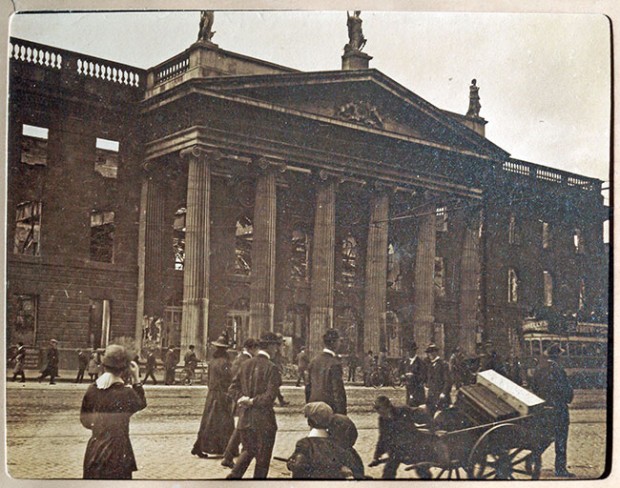
Apostles of freedom are ever idolised when dead, but crucified when alive. – James Connolly
1858
MARCH 17th – Irish Republican Brotherhood (IRB) is founded in Dublin by James Stephens.
1884
NOVEMBER 1st – Gaelic Athletic Association (GAA) is founded in Thurles, County Tipperary, by Michael Cusack and Maurice Davin.
1893
JULY 31st – Gaelic League (Conradh na Gaeilge) is founded by Douglas Hyde, Eoin MacNeill and Father Eugene O’Growney.
1900
Inghinidhe na hÉireann (Daughters of Ireland), a revolutionary women’s society, is founded on Easter Sunday.
1905
NOVEMBER 28th – Sinn Féin is founded in Dublin.
1907
APRIL – Augustine Birrell is appointed British Chief Secretary in Ireland.
1908
SEPTEMBER 8th – St Enda’s (Scoil Éanna) is founded by Pádraig Pearse at Cullenswood House, Ranelagh, Dublin.
1909
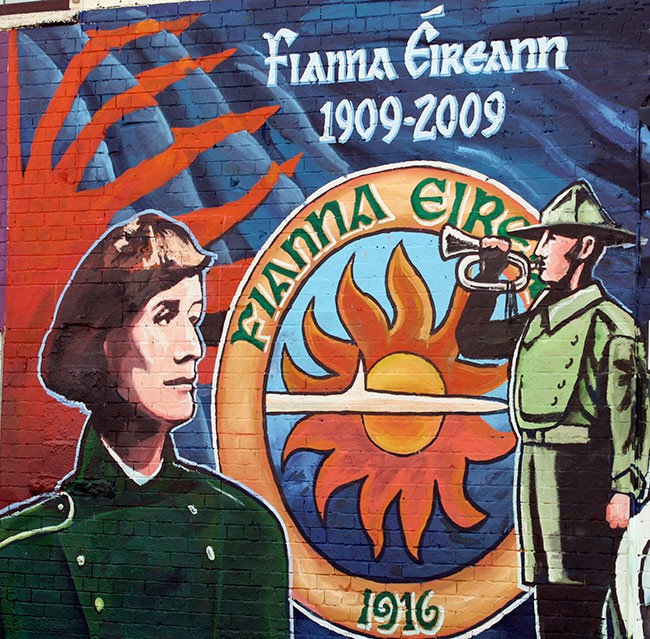
AUGUST 16th – Fianna Éireann, the republican scouting organisation, is founded in Dublin by Constance Markievicz.
1910
SEPTEMBER 15th – Irish Freedom, the official newspaper of the IRB, is launched.
SEPTEMBER – St Enda’s is moved to the Hermitage at Rathfarnham, Dublin.
1912
APRIL 11th – Third Home Rule Bill is published by the British Government.
SEPTEMBER 28th – Solemn League and Covenant signed in Belfast by unionists led by Edward Carson.
1913
JANUARY – Home Rule Bill passes all stages in British House of Commons. Home Rule Bill is defeated in British House of lords. Ulster Volunteer Force is formally established.
JULY – Home Rule Bill again passed in British House of Commons and once again defeated in the House of Lords.
AUGUST 16th – The 1913 Great Lock-Out of workers by employers, led by William Martin Murphy, begins.
AUGUST 31st – Dublin Metropolitan Police baton charge workers at a public meeting in O’Connell Street, Dublin, following an address by trade union leader Jim Larkin.
SEPTEMBER – Provisional Government of Ulster is set up by unionist leaders and members of the Ulster Volunteer Force (UVF) in Belfast.
SEPTEMBER 14th – James Connolly, imprisoned in Mountjoy Jail for attending meeting in O’Connell Street two weeks previously, begins hunger strike.
SEPTEMBER 21st – James Connolly released from prison after a week on hunger strike.
NOVEMBER 1st – In response to the formation of the UVF, Eoin MacNeill, in an article in An Claidheamh Soluis, urges the setting up of the Irish Volunteers.
NOVEMBER 11th – A small group of senior members of the IRB attend a private meeting in Wynn’s Hotel, Dublin, to plan the establishment of the Irish Volunteers.
NOVEMBER 23rd – The Irish Citizen Army is founded in Dublin by Jim Larkin.
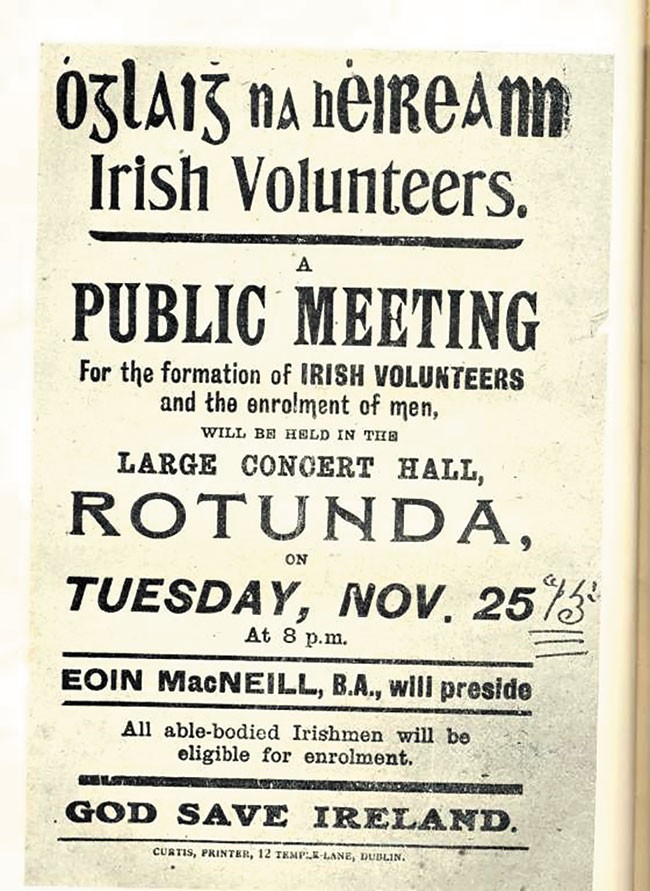
NOVEMBER 25th – Inaugural meeting of the Irish Volunteers is held at the Rotunda Rink in Dublin.
NOVEMBER 26th – Sir John Ross, Chief Commissioner of the Dublin Metropolitan Police, reports to Dublin Castle authorities that strikers are drilling.
DECEMBER 5th – British Government issues an order banning the importation of arms in to Ireland.
DECEMBER 23rd – First company of Irish Volunteers is formed in Cork.
1914
MARCH 21st – Curragh Mutiny: British Army officers give notice of their refusal to move against the loyalists.

APRIL 2nd – Cumann na mBan founded in Dublin.
APRIL 25th – UVF lands 35,000 German rifles at Larne Harbour.
APRIL – John Redmond, leader of the Irish Parliamentary Party, agrees that individual counties can opt out of the Home Rule proposals for six years.
MAY 24th – Home Rule Bill is passed in the British House of Commons for the third time.
JUNE – John Redmond issues ultimatum to the Provisional Committee of the Irish Volunteers to co-opt 25 people nominated by him on to the committee.
JUNE 28th – Archduke Franz Ferdinand of Austria is shot dead.
JULY 16th – Sir John Ross, Dublin Metropolitan Police Chief Commissioner, reports to Dublin Castle authorities the armed drilling by the Volunteers in Dublin.
JULY 23rd – Austria issues ultimatum to Serbia.
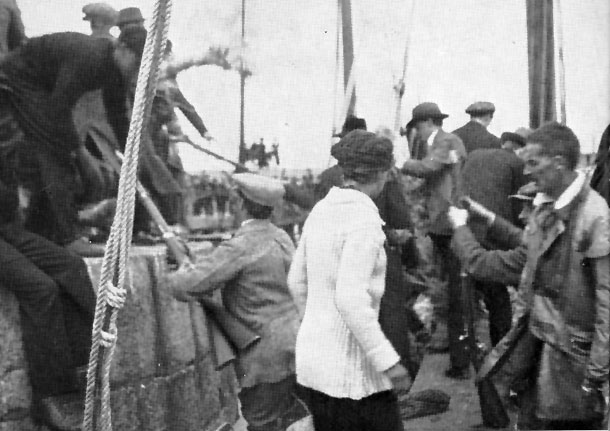
JULY 26th – Howth gun-running: Irish Volunteers unload 900 rifles and 20,000 rounds of ammunition from the Asgard at Howth, County Dublin. British soldiers of the King’s Own Scottish Borderers open fire on civilians at Bachelor’s Walk in Dublin, killing four and wounding 37 people.
AUGUST 1st – Irish Volunteers unload 600 rifles at Kilcoole in County Wicklow.
AUGUST 4th – Britain declares war on Germany.
AUGUST 8th – Four days after the beginning of World War I, the Defence of the Realm Act (DORA) comes into force in Ireland to deal with any “manifestation of sedition or treason”.
SEPTEMBER – Third Home Rule Bill receives the royal assent but its operation is suspended until the end of World War I.
SEPTEMBER 5th – Supreme Council of the IRB decides on a rising before the end of the European war.
SEPTEMBER 24th – John Redmond, in a speech at Woodenbridge in County Wicklow, urges Irishmen to support the British during the war. Following this, his 25 nominees are expelled from the Provisional Committee of the Irish Volunteers. James Connolly, Commander-in-Chief of the Citizen Army, addresses an anti-recruiting meeting in Dublin.
SEPTEMBER 25th – As a result of John Redmond’s speech at Woodenbridge, the Irish Volunteers split. British Prime Minister Herbert Asquith and John Redmond address a British Army recruiting meeting in Dublin.
SEPTEMBER 26th – John Redmond orders his followers to form a new organisation called the National Volunteers.
OCTOBER 5th – Sir Matthew Natham is appointed Under-Secretary at Dublin Castle to Chief Secretary Augustine Birrell.
OCTOBER 25th – At an Irish Volunteer convention in Dublin, Pádraig Pearse and Thomas MacDonagh are elected to the 62-strong General Council. Pádraig Pearse, Joseph Plunkett and Eamonn Ceannt are appointed to a new advisory committee within the IRB to draw up plans for a rising.
OCTOBER – The military headquarters staff of the Irish Volunteers is established: Pádraig Pearse appointed Director of Military Operations; Eoin MacNeill, Chief of Staff; Martin Joseph O’Rahilly (The O’Rahilly), Director of Arms; Thomas MacDonagh, Director of Training; Joseph Plunkett, Director of Military Operations; Eamonn Ceannt, Director of Communications; and Bulmer Hobson, Quartermaster-General.
1915
MARCH – Thomas MacDonagh is appointed by Pádraig Pearse as Officer Commanding the Dublin Brigade, Irish Volunteers.
MARCH 10th – Pádraig Pearse, as Director, of Military Organisation, appoints Thomas MacDonagh, Eamonn Ceannt, Edward Daly and Eamon de Valera (all senior members of the IRB) as commandants of the four Dublin battalions of the Irish Volunteers.
MARCH 13th – At a meeting of the four new Dublin commandants of the Irish Volunteers with Pádraig Pearse, the possibility of a rising is discussed and military roles assigned to each battalion.
MARCH 16th – The Defence of the Realm Act No. 2 (permitting trial by jury in Ireland) is passed by the British House of Commons.
MARCH 17th – Thousands of armed Volunteers parade in Dublin and Limerick.
APRIL 4th – On Easter Sunday, mock battles are staged for some of the Dublin Volunteer companies.
MAY – A Coalition government, which includes the prominent unionists Bonar Law and Edward Carson, is formed in England under Prime Minister Lloyd George. The lapsed IRB Advisory Committee on Military Affairs is re-formed as the Military Committee and briefed to draw up specific plans for a rising. Committee is made up of Pádraig Pearse, Joseph Plunkett and Eamonn Ceannt. Joseph Plunkett travels to Germany to negotiate an arms shipment to Ireland for the following September.
MAY 29th – First Issue of Workers’ Republic, published by James Connolly, appears.
JUNE 29th – Pádraig Pearse delivers the oration at the grave of Wolfe Tone at Bodenstown, County Kildare.
JUNE 29th – The death occurs of Fenian Jeremiah O’Donovan Rossa in New York.
AUGUST 1st – Pádraig Pearse delivers his historic oration at the funeral of O’Donovan Rossa in Glasnevin Cemetery, Dublin.
SEPTEMBER – Seán Mac Diarmada is released from prison having served a four-month sentence for an anti-recruiting speech delivered in Tuam, County Galway. At a meeting of senior IRB men, the Military Committee becomes the Military Council and its number is raised to five by the addition of Thomas Clarke and Seán Mac Diarmada. The secret Military Council fixes Easter Sunday 23 April 1916 as the date for the Rising. Denis McCullough, the Belfast member of the Supreme Council of the IRB, is elected President.
OCTOBER 6th – Eighty-five armed Citizen Army men carry out a mock attack on Dublin Castle.
OCTOBER 24th – One hundred and twenty men of the Citizen Army, 12 women of Cumann na mBan and 20 Fianna boys carry out manoeuvres in the neighbourhood of Dublin Castle.
NOVEMBER At a meeting in Liberty Hall to commemorate the Manchester Martyrs, James Connolly, Commander-in-Chief of the Citizen Army, expresses impatience at the lack of preparations for a rising.
DECEMBER 5th – Seventy-six armed Citizen Army men carry out manoeuvres at Cross Guns Bridge and other bridges along the Royal Canal while a party of the Citizen Army carries out a raid for arms at Sutton, County Dublin.
1916
JANUARY 9th – At a meeting with the Military Council, James Connolly is taken into its confidence regarding the planned rising and is sworn into the IRB and co-opted onto the Military Council.
JANUARY 23rd – Detectives of the ‘G’ Division of the Dublin Metropolitan Police raid the home of Constance Markievicz at Surrey House, Rathmines, Dublin, in a search for arms – none are found.
FEBRUARY – The Military Council makes contact with Clan na Gael in America. John Devoy notifies the German Government that a rising is planned for Easter Sunday and arms should be sent to Ireland between Friday 21 April and Sunday 23 April.
FBBRUARY 5th – About 350, Volunteers, 200 of whom are armed, assembled at Blackhall Place, Dublin, and engage in manoeuvres which extend as far as the Phoenix Park, North Circular Road, King’s Bridge [now Seán Heuston Bridge] and Thomas Street.
FEBRUARY 12th – Joseph McGarrity, leader of Clan na Gael in America, receives a message from Pádraig Pearse confirming that rifles are needed between Good Friday and Easter Sunday. The Gaelic Athlete, the official organ of the GAA, calls on its readers to join the Irish Volunteers.
MARCH – Liam Mellows is arrested and deported to England.
MARCH 9th – Clan na Gael leader Joseph McGarrity sends a message to Pádraig Pearse and Thomas Clarke informing them that 20,000 rifles, ten machine guns and ammunition will be landed at Tralee, County Kerry, between Good Friday 21 April and Easter Sunday 23 April.
MARCH 17th – Three thousand Volunteers of the Dublin Brigade parade at College Green. Volunteers hold parades throughout Ireland.
MARCH 24th – Detectives of the ‘G’ Division of the Dublin Metropolitan Police raid the printing works of Irish Republic, beside liberty Hall. James Connolly mobilises members of the Citizen Army to defend Liberty Hall in case of an attack or raid by the police.
APRIL 3rd – Pádraig Pearse, as Director of Military Organisation, issues orders for three days’ march and manoeuvres by the Irish Volunteers at Easter.
APRIL – Thomas MacDonagh is co-opted onto the Military Council, bringing the number of members to seven.
APRIL 9th – The arms ship, the Aud, commanded by Captain Karl Spindler with a crew of 21, leaves Lübeck for Ireland. The Catholic Hierarchy, in a Lenten pastoral, refutes suggestions that the Catholic Church in Ireland is opposed to England or to recruiting for the British Army.
APRIL 12th – Roger Casement and Robert Monteith sail from Germany on board the submarine U20.
APRIL 15th – Roger Casement disembarks from the submarine U20 at Heligoland and joins the U19, which had sailed early in the morning from Emden. The Gaelic Athlete is forced to cease publication due to constant harassment from the Royal Irish Constabulary (RIC).
APRIL 16th – James Connolly inspects members of the Citizen Army and hoists the Irish flag over their headquarters at Liberty Hall. The Aud is between Ireland and Faeroe. The UI9, with Roger Casement on board, is in the North Sea. At 7:30pm, the Aud encounters the British warship, HMS Orcoma, increases speed and changes course.
APRIL 17th – The Aud is off Rockall while the UI9 is between Shetland and Norway. The Proclamation of the Irish Republic is prepared by Pádraig Pearse.
APRIL 18th – The Dublin Castle authorities learn that an arms ship has left Germany for Ireland in early April.
APRIL 19th – The Aud approaches the south-west of Ireland and the crew prepares the cargo for discharge. The German submarine, U19, passes the Hebrides. Eoin MacNeill, Chief of Staff of the Irish Volunteers, learns of the proposed Rising from Bulmer Hobson and issues orders cancelling Easter manoeuvres by the Volunteers. The ‘Castle Document’ – giving details of the British General Friend’s order to disarm the Volunteers and to arrest the leaders – is ciruclated by the Military Council among the Volunteer leaders. A copy is given to Eoin MacNeill.
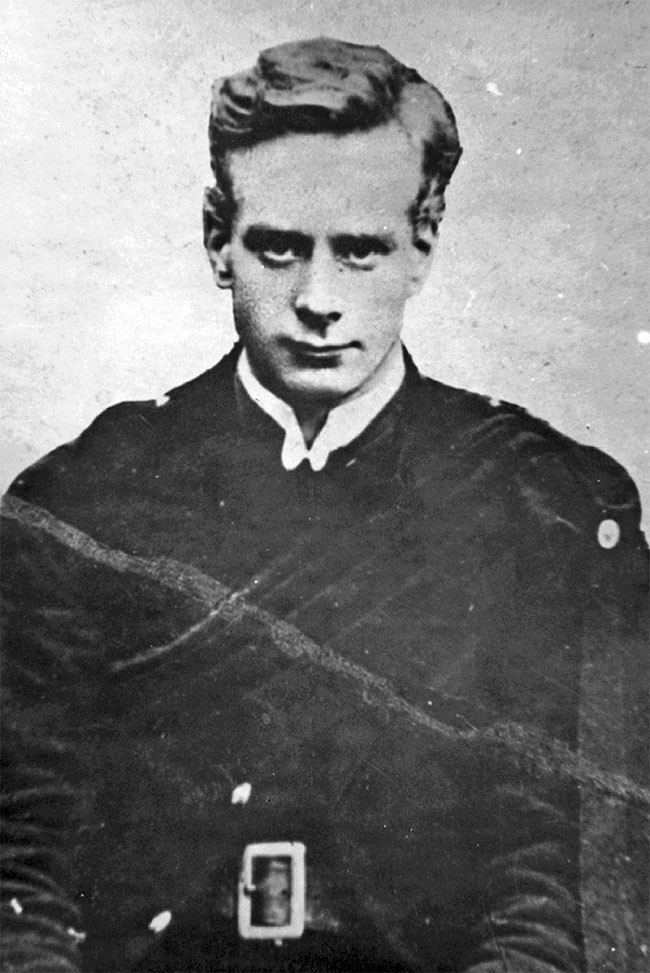
APRIL 20th – Liam Mellows, deported the previous month, arrives back in Dublin having escaped from England. The arms ship, the Aud, arrived off the Kerry coast. Eoin MacNeill and Bulmer Hobson visit Pádraig Pearse at St Enda’s and are told by Pearse that a rising is in fact being planned for the following Sunday at 4pm. MacNeill says that he will do all in his power to stop the Rising, short of informing to the British. Five Volunteers chosen to set up a transmitter at Ballyard, near Tralee, to send out messages to British warships to decoy them from the Kerry coast, are given final briefing at a meeting at 8pm by Seán Mac Diarmada. The Aud approaches Tralee Bay and the German submarine with Roger Casement on board anchors off Castlegregory at midnight.
APRIL 21st – At 12:10am, the submarine U19 reaches the planned rendezvous point with the Aud. Unaware of the change in plan to land the arms at Fenit, County Kerry, on Easter Sunday instead of Good Friday, the Aud anchors off Tralee Bay for 24 hours. Roger Casement, Captain Robert Monteith and Daniel J. Bailey, a member of the Irish Brigade, land in a dinghy from the German submarine U19 at 2:15pm at Banna Strand. The Aud attracts the attention of a British patrol boat, Setter, in the morning and in the early afternoon weighs anchor to escape the British vessel, Lord Heneage. Submarine U19 searches for the Aud off Tralee Bay from 12:10am until after 4am, then sails south to attack British shipping. British patrol boats HMS Bluebell and HMS Zinnia give chase to the Aud and force Captain Spindler to make for Queenstown [now Cobh]. The five Volunteers chosen to set up a transmitter at Ballyard, County Kerry, travel by train in the morning from Dublin to Killarney. At 1:30pm, Roger Casement is arrested at McKenna’s Fort at Banna Strand, County Kerry, by armed RIC police and taken to Tralee Barracks. Captain Robert Monteith and Daniel J. Bailey journey to Tralee, where Bailey is captured. Monteith escapes and makes his way to Cork. The leader of the Kerry Volunteers, Austin Stack, is arrested. Eoin MacNeill, Chief of Staff of the Irish Volunteers, issues further orders cancelling Pádraig Pearse’s instruction for a mobilisation of all Volunteers on Easter Sunday and appoints Bulmer Hobson as Commandant of the Dublin area. Hobson, a member of the Supreme Council of the IRB, is arrested by the Military Council because of his attempts to sabotage the plans for the Rising. Pádraig Pearse and Thomas MacDonagh have a meeting with Eoin MacNeill and inform him of the proposed arms landing in Kerry. MacNeill says that he will continue with his cancellation of all Easter manoeuvres if the landing of arms is unsuccessful. Three of the five Volunteers sent to Kerry to set up the transmitter to send out decoy messages to British warships are drowned in the River Laune after driving over the pier at Ballykissane because of the dense fog. The three are Charles Monahan, Donal Sheehan and Con Keating.
APRIL 22nd – At 9:28am, rather than have his cargo of arms fall into the hands of the British, Captain Karl Spindler and his crew scuttle the Aud south-east of Daunt Rock, off the Kerry coast, and board a lifeboat. On learning of the scuttling of the Aud, Eoin MacNeill dispatches messages throughout the country, cancelling the Easter manoeuvres for all Volunteers.
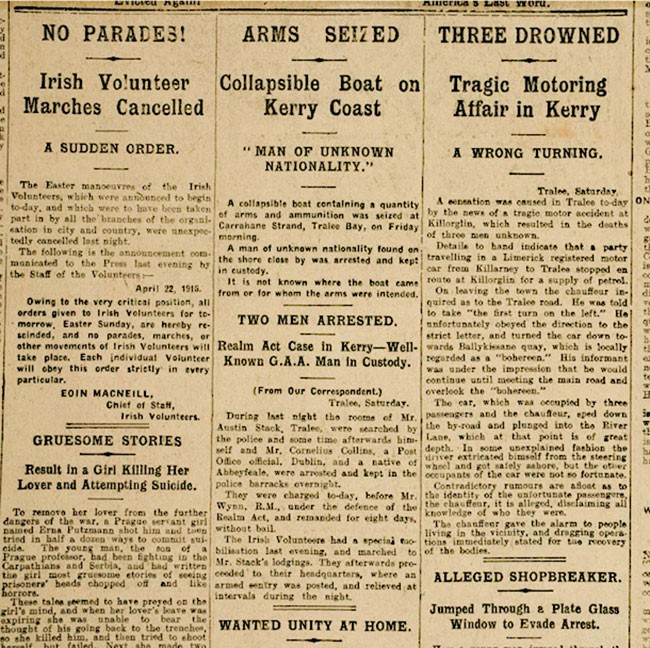
APRIL 23rd – Eoin MacNeill’s order cancelling all manoeuvres by the Volunteers over the Easter weekend is published in the Sunday Independent. A meeting of the Military Council in Liberty Hall forms a Provisional Civil Government comprising Alderman Tom Kelly, Arthur Griffith, William O’Brien, Hannah Sheehy-Skeffington and Seán T. O’Kelly. Denis McCullough, President of the IRB, tries to find support in Belfast for the orders from Pádraig Pearse and James Connolly to transport his men to join with the western forces. A meeting of the Military Council at 9am in Liberty Hall confirms the cancellation of the mobilisation for Sunday but decides to delay the Rising for one day and to carry out the plans on Easter Monday. Following the capture of Roger Casement and the scuttling of the Aud, the British Lord Lieutenant in Ireland, Lord Wimbourne, orders the arrest of all known republican leaders. A Provisional Revolutionary Government is formed from among the members of the Military Council. Its members are Pádraig Pearse, Thomas Clarke, Thomas MacDonagh, Joseph Plunkett, Eamonn. Ceannt, James Connolly and Seán Mac Diarmada. At a meeting of the Military Council in Liberty Hall, Pádraig Pearse is elected President of the newly-formed Provisional Government and Commander in Chief of the Army of the Irish Republic. The Proclamation of the Irish Republic is printed in Liberty Hall by Michael Molloy, Christopher Brady and Liam O’Brien. The seven members of the Provisional Government assemble in Liberty Hall; Thomas Clarke, Pádraig Pearse, Thomas MacDonagh, James Connolly, Eamonn Ceannt, Joseph Plunkett and Seán Mac Diarmada sign the Proclamation of the Irish Republic.
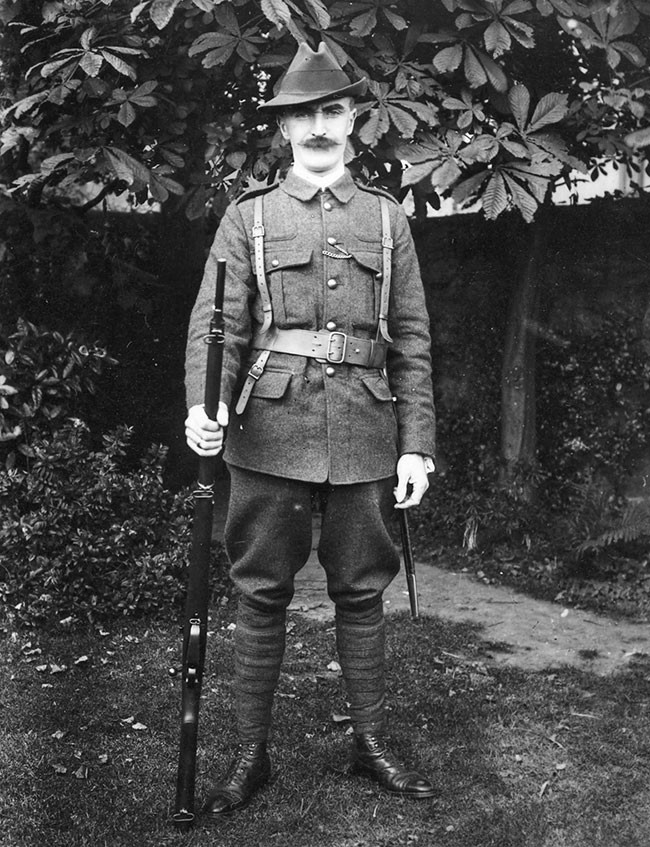
APRIL 24th – The O’Rahilly, who has spent the weekend driving around the east and midlands with Eoin MacNeill’s cancellation order, joins Pádraig Pearse and the other leaders at Liberty Hall. Early in the morning, Thomas MacDonagh, as O/C of the Dublin Brigade of the Irish Volunteers, orders all four battalions to parade for inspection and route marches at 10am. At noon, Pádraig Pearse, President of the Provisional Government of the Irish Republic and Commander in Chief of the Army of the Irish Republic reads the Proclamation from the steps of the GPO. The Irish Republic is declared by a section of the Volunteers controlled by the IRB, Irish Citizen Army, Fianna Éireann, Cumann na mBan and the Hibernian Rifles. The Easter Rising begins in Dublin. The 1st Battalion (under Commandant Edward Daly) occupies the Four Courts; the 2nd Battalion (Commandant Thomas MacDonagh) takes Jacobs factory; the 3rd Battalion (Commandant Éamon de Valera) secures Boland’s Mills; the 4th Battalion moves into the South Dublin Union, James’s Street. Irish Volunteers, members of Fianna Éireann, Cumann na mBan and the Hibernian Rifles occupy the General Post Office (GPO) in Sackville Street [now O’Connell Street], Captain Seán Heuston occupies the Mendicity Institute, and Commandant Michael Mallin (Chief of Staff of the Irish Citizen Army), occupies St Stephen’s Green. Various positions throughout the city are seized and occupied. Bulmer Hobson, arrested by the Military Council on the previous Friday, is released and takes no part in the fighting. Nurse Keogh is shot dead by British soldiers in the grounds of the South Dublin Union while tending the wounded.
APRIL 25th – John Dillion, deputy leader of the Irish Parliamentary Party, telegrams his party leader, John Redmond, urging him to stay in London until he can send details of the events on Dublin. The pacifist Francis Sheehy-Skeffington, who organised an anti-looting campaign during the first two days of the Rising, is arrested by the British at Portobello Bridge while returning to his home. The British gunboat Helga anchors off the Pigeon House Fort at the mouth of the Liffey at 11:45pm and fires two shells at Boland’s Mills. The British Army occupies the Shelbourne Hotel and the United Services Club and fires on the Volunteers and the Citizen Army troops in St Stephen’s Green, forcing them to withdraw to the College of Surgeons.
APRIL 26th – Francis Sheehy-Skefftngton and two journalists, Thomas Dickson and Partick Mclntyre, are murdered by the British Army in Portobello Barracks, Rathmines. The Helga moves up the Liffey and shells Liberty Hall and the republican headquarters at the GPO. Seán Heuston and his small garrison are forced to evacuate the Mendicity Institute and surrender. The Battle of Mount Street Bridge begins. British reinforcements from England advanced from Kingstown [now Dún Laoghaire] and attack the small posts in the Landsdowne Road area. A fierce firefight takes place at Mount Street Bridge where seven Volunteers, with supporting units, held Clanwilliam House for nine hours against 800 British soldiers. This position suffers bomb and grenade attacks and catches fire. Three of the defending party are killed. After a heroic defence, the post is evacuated by the four survivors. The British suffer their heaviest casualties of the Rising: 216 killed or wounded. The British gunboat Laburnum sees action against the republican forces in Galway Bay, where she fires nine rounds.
APRIL 26th – The British battleship HMS Albion is ordered from Plymouth to Haulbowline in Cork. The British cruiser The Adventurer is sent from Haulbowline to Kingstown with reinforcements.
APRIL 27th – Fr Felix Watters, a Marist priest, is shot while tending the wounded in the Northumberland Road area of Dublin during the Battle of Mount Street Bridge. John Redmond, leader of the Irish Parliamentary Party, condemns the Rising during a British House of Commons speech. The British cruiser Gloucester arrives in Galway Bay. The British sloop Snowdrop leaves Haulbowline for Galway with 100 marines as a landing party. The British destroyers Ossory, Onslow and Nictor (detached from the Grand Fleet’s Scottish bases), and the Dee and the Dove (Liverpool based) escort troops from Liverpool to Kingstown. Artillery attacks and incendiary bombing of the GPO by the British continues throughout the day. Fires raging throughout O’Connell Street spread to other buildings in the city centre. James Connolly is seriously wounded but continues to direct the defence of the GPO from a stretcher. The Four Courts are shelled by British artillery and armoured cars attack republican outposts in the North King Street area of the city.
APRIL 28th – The bombardment of the republican headquarters at the GPO continues and incendiary shells set the building on fire. Prisoners taken during the week, members of Cumann na mBan and wounded Volunteers are evacuated from burning GPO. James Connolly, though badly injured, remains with the garrison in the GPO. Michael Joseph O’Rahilly (The O’Rahilly) is shot dead at the corner of Moore Street and Great Britain Street [now Parnell Street] while leading an evacuation party from the burning GPO. With the GPO in flames, Pádraig Pearse orders the complete evacuation of the burning building. The last of the Volunteers, led by Pádraig Pearse, evacuates the GPO and sets up a new headquarters at 16 Moore Street. General Sir John Maxwell arrives from England as Commander in Chief of the British forces in Ireland with complete control over the country under martial law. John Redmond, leader of the Irish Parliamentary Party, in a media interview, says that the Rising is all part of a “German Plot”. At the Battle of Ashbourne, in County Meath, one of the most successful engagements of the Rising, Volunteers of the 5th Battalion of the Dublin Brigade (the Fingal Battalion led by Thomas Ashe) attack the RIC police barracks at Ashbourne and inflict heavy casualties. Soldiers of the South Staffordshire Regiment of the British Army shoot dead 15 civilians in the North King Street area of Dublin.
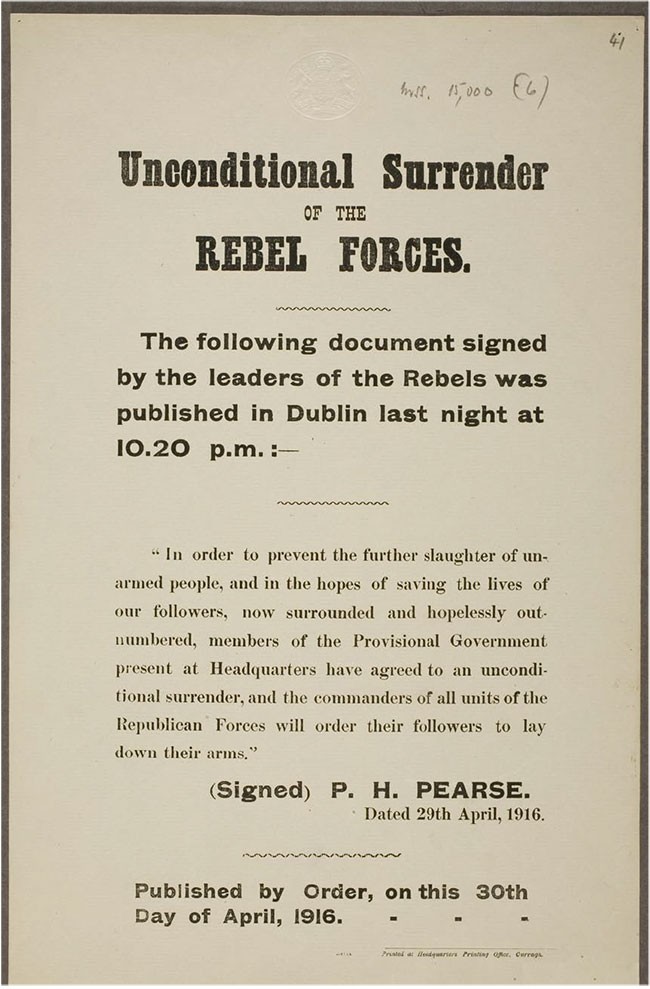
APRIL 29th – Members of the Provisional Government (with the exception of Thomas MacDonagh and Eamonn Ceannt, who were in command of garrisons in the Four Courts and the South Dublin Union) decide that, since a military victory is now out of the question, to negotiate for terms of surrender. At noon, a Cumann na mBan Volunteer, Nurse Elizabeth O’Farrell, carrying Commandant Pádraig Pearse’s message proposing the negotiation of terms of surrender, meets British Army officer Leiutenant Colonel Owens at the corner of Moore Street and Parnell Street. At 1:40pm, Nurse O’Farrell returns to the republican headquarters at 16 Moore Street with a message from British Army Brigadier-General Lowe that he will only accept an unconditional surrender. At 3:30pm, Pádraig Pearse, accompanied by Nurse O’Farrell, surrenders to Brigadier-General Lowe at the junction of Moore Street and Parnell Street. At 3:45pm, Pádraig Pearse, while a prisoner in the British military headquarters in Parkgate Street, signs a general order of unconditional surrender for other commands to lay down their arms. At 4pm, the remainder of the GPO garrison, led by Willie Pearse, surrenders to the British in Moore Street. The wounded James Connolly is taken on a stretcher to the military hospital in Dublin Castle. Late in the afternoon, the Four Courts garrison, led by Edward Daly, surrenders to the British. Four hundred prisoners from the GPO and Four Courts garrisons are kept in the open during the night in the grounds of the Rotunda Hospital.
APRIL 30th – Republican forces in all the remaining garrisons and outposts in Dublin surrender. The republican prisoners who have been kept in the open throughout Saturday night in the grounds of the Rotunda are taken to Richmond Barracks at Inchicore. John Dillon, deputy leader of the Irish Parliamentary Party, writes to his party leader, John Redmond, from Dublin asking him to urge the British Government not to shoot any of the republican prisoners “for the present”. Hundreds of republican prisoners were taken from Richmond. Barracks to the North Wall to be interned in Wales and England.
MAY 1st – A party of RIC police officers and British soldiers surround the home of Thomas Kent at Bawnard House, Castlelyons, in Cork. In the fierce engagement which follows, one policeman is killed and several soldiers are injured before the Kent family surrender due to a shortage of ammunition. The British Chief Secretary to Ireland, Augustine Birrell, and the Under-Secretary, Matthew Natham, resign because of their failure to anticipate the Rising.
MAY 2nd – General Sir John Maxwell, who has been sent to Ireland to put down the Rising, denies that anyone has been shot without trial. Pádraig Pearse, Thomas Clarke and Thomas MacDonagh are court-martialled in Richmond Barracks and sentenced to death.
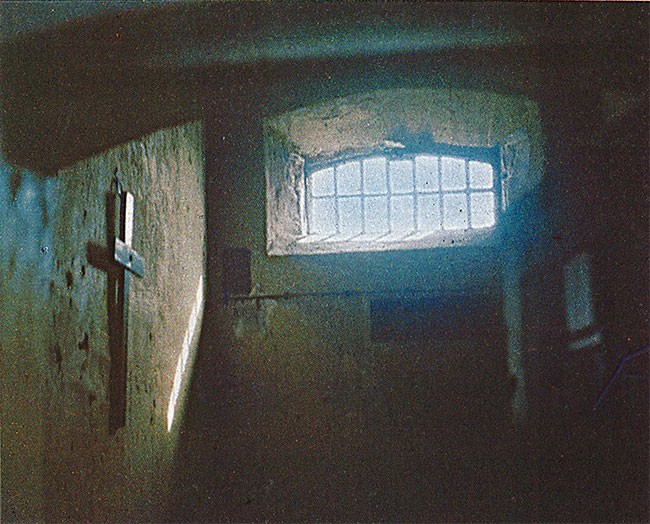
MAY 3rd – Thomas Clarke, Pádraig Pearse and Thomas MacDonagh are executed by firing squad in the yard of Kilmainham Gaol between 3am and 3:30am. John Redmond, speaking in the British House of Commons, congratulates the British for having put down the Rising in Ireland and urges the British Government not to show undue severity to the rank and file who participated in the Rising. Asquith, the British Prime Minister, assures John Redmond that “a few executions will be necessary, but that they will be very few”. Shortly before his execution, Joseph Plunkett marries Grace Gifford in the small church in Kilmainham Gaol.
MAY 4th – Willie Pearse, Joseph Plunkett, Edward Daly and Michael O’Hanrahan are executed by firing squad in the yard of Kilmainham Gaol.
MAY 5th – John MacBride is executed by firing squad in the yard of Kilmainham Gaol.
MAY 6th – Constance Markievicz and 18 other political prisoners are court-martialled and sentenced to death. The British Cabinet decides that General Sir John Maxwell should be given a free hand in the matter of executions but specifies that no women are to be executed. The death sentence imposed on Constance Markievicz earlier in the day is commuted to one of imprisonment for life.
MAY 8th – Con Colbert, Seán Heuston, Eamonn Ceannt and Michael Mallin are executed by firing squad in the yard of Kilmainham Gaol. Fr Felix Watters, shot while tending the wounded during the Battle of Mount Street Bridge, dies.
MAY 9th – Thomas Kent is executed by firing squad in Cork Jail.
MAY 11th – In a leading article in the Irish Independent, William Martin Murphy MP, who was responsible for the Great Lock-Out of workers in 1913, urges General Maxwell to execute James Connolly. The British House of Commons debates ‘The Irish Crisis’ during which John Dillon, who now realises that the executions are generating sympathy for the republicans, denounces the severity of Maxwell in dealing with the Rising.
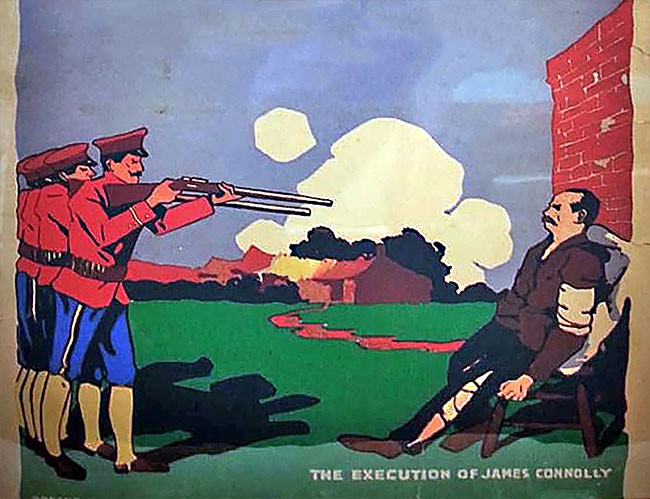
MAY 12th – The wounded James Connolly, who is strapped into a chair, and Seán Mac Diarmada are executed by firing squad in the yard of Kilmainham Gaol. British Prime Minister Asquith arrives in Ireland and visits Dublin, Cork and Belfast during his week-long stay.
MAY 13th – The Bishop of Limerick, Dr Edward O’Dwyer, writes to General Sir John Maxwell and condemns his execution of the leaders of the Rising.
MAY 15th – Roger Casement is arraigned on a charge of high treason.
MAY 17th – In an open letter to General Sir John Maxwell, Dr Edward O’Dwyer describes his regime in Ireland as “one of the worst and blackest chapters in the history of misgovernment in the country”.
MAY 29th – Lloyd George, sent to Ireland by the British Government, announces a plan to implement Home Rule in 26 counties and to exclude the six north-eastern counties from an Irish legislature until after the European War.
JUNE 1st – General Sir John Maxwell writes to British Prime Minister Asquith complaining that Catholic priests are offering Mass for the repose of the souls of those killed during the Easter Rising and for the executed leaders.
JUNE 23rd – A meeting of the Irish Parliamentary Party agrees to Lloyd George’s plan for Home Rule for 26 counties.
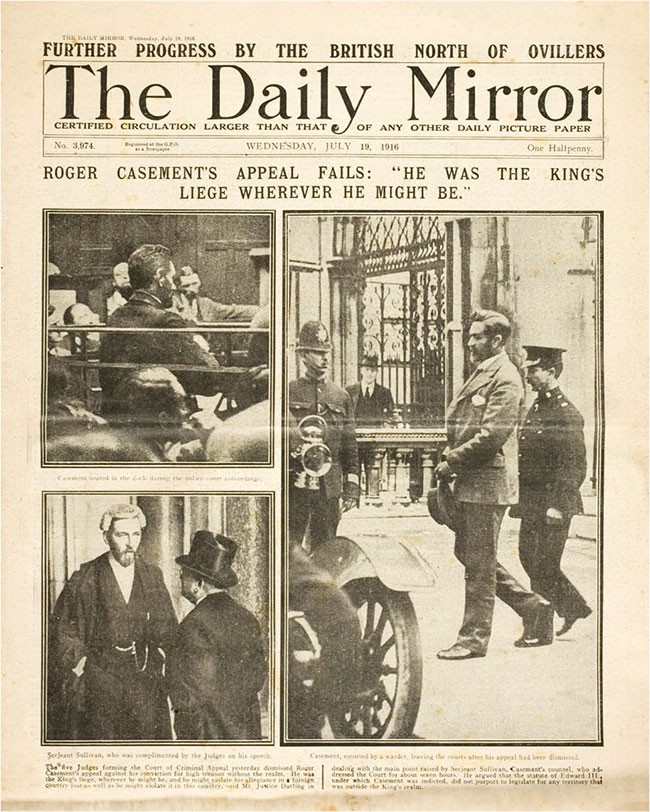
JUNE 26th – The trial of Roger Casement, imprisoned in the Tower of London since his arrest, begins at the Old Bailey in London.
JUNE 29th – Roger Casement is found guilty of high treason and sentenced to death by hanging.
JULY – While efforts are being made to organise a reprieve for Casement, alleged copies of his diaries are circulated by the British in an attempt to discredit him.
JULY 11th – Lloyd George announces that the exclusion of the six counties from the 26-county legislature being set up under his Horne Rule scheme will be permanent.
JULY 15th – The Irish Volunteer Dependants’ Fund is established by Kathleen Clarke, widow of executed leader Thomas Clarke, to aid the dependants of those imprisoned and interned following the Easter Rising.
JULY 24th – John Redmond, leader of the Irish Parliamentary Party, withdraws his support for Lloyd George’s scheme to give Home Rule to the 26 counties because of the permanent exclusion of the six counties. The Home Rule scheme collapses.
JULY – The Bishop of Limerick, Dr Edward O’Dwyer, the first member of the Catholic Hierarchy to defend the action of the insurgents of Easter Week, tells General Sir John Maxwell that he will not discipline two priests, both noted nationalists, for supporting the Rising.
AUGUST 3rd – Roger Casement, sentenced to death for his part in the Easter Rising, is hanged at Pentonville Prison, London.
AUGUST – The first of the 2,000 republicans interned in England and Wales since the Rising are released.
AUGUST 16th – The Irish Volunteers Dependants’ Fund merges with the Irish National Aid Association with the aim of establishing a national organisation to raise funds for the dependants of the deceased and imprisoned Irish Volunteers.
AUGUST 23rd – The inquest into the death of Francis Sheehy-Skeffington opens. His widow, Hanna Sheehy-Skeffington, refuses the British offer of compensation for her husband’s murder.
SEPTEMBER 14th – Dr Edward O’Dwyer, Bishop of Limerick, in recognition of his stand in defending the actions of the Easter Week rebels, is granted the Freedom of the City of Limerick
DECEMBER 24th – The remaining Volunteers interned in Frongoch and other internment camps in Wales and England since the Rising are released.
1917
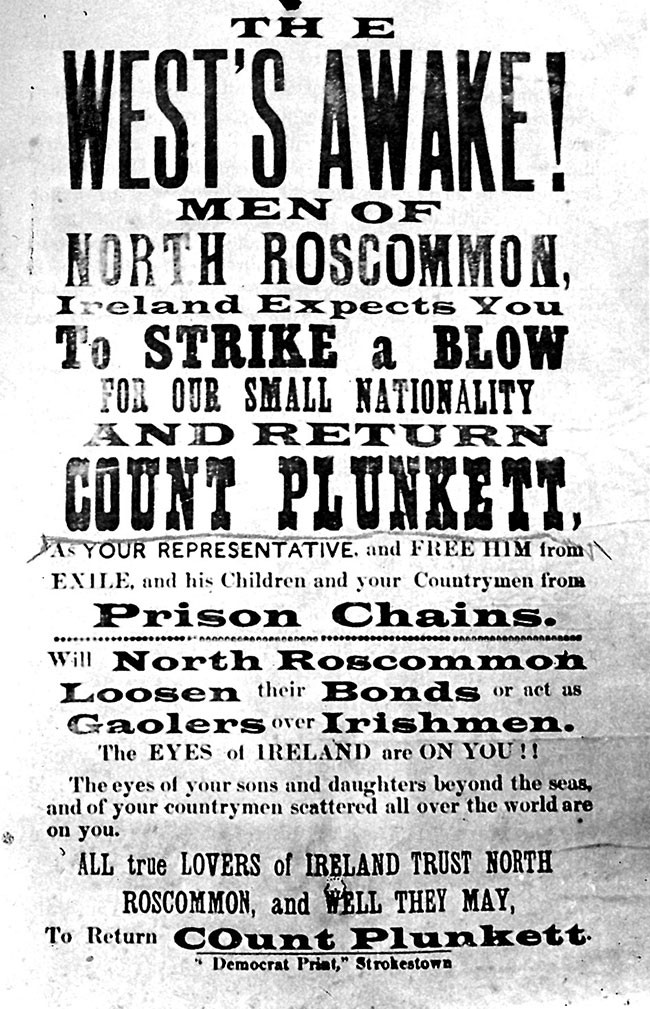
FEBURARY 5th – Count Plunkett, father of the executed 1916 leader Joseph Plunkett, is elected as Sinn Féin representative for North Roscommon.
JUNE 17th – The last of the sentenced republican prisoners who have been imprisoned in England since the Rising the previous year are released.
JUNE 18th – A huge public reception is held at Westland Row in Dublin for the arrival in Ireland of hundreds of sentenced political prisoners following their release from jail in England.
JUNE 21st – A public reception is held in Dublin for Constance Markievicz following her release from Parkhurst Prison in England.
Follow us on Facebook
An Phoblacht on Twitter
Uncomfortable Conversations

An initiative for dialogue
for reconciliation
— — — — — — —
Contributions from key figures in the churches, academia and wider civic society as well as senior republican figures




